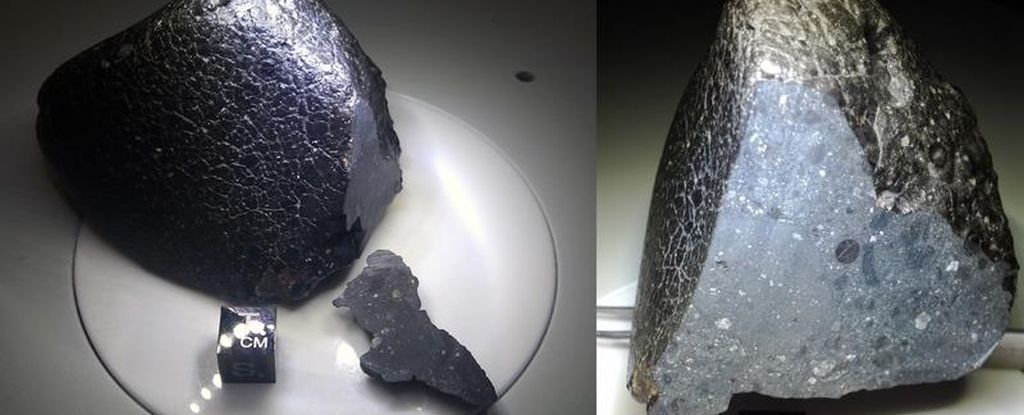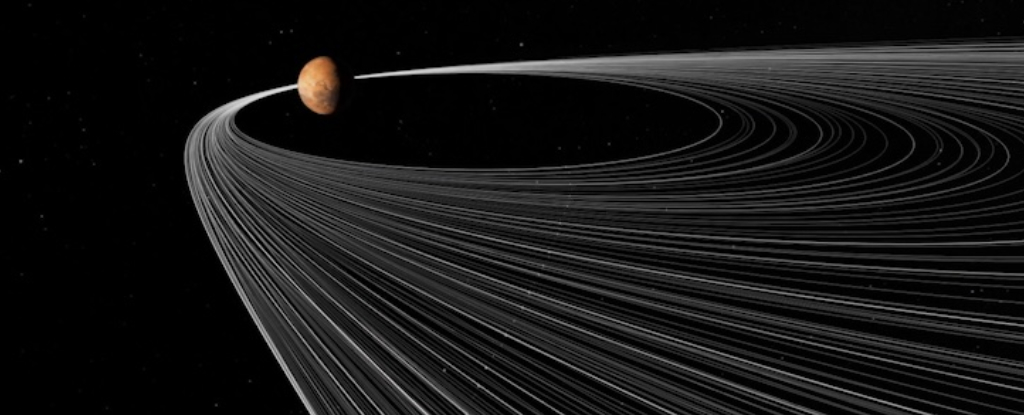ARTICLE AD
We have a whole lot of weird moons in the Solar System. We have hot moons and cold moons. There's a moon with liquid and many moons that are dusty. One planet has a walnut moon, and another has potato moons.
But of the nearly 300 moons found to date, not a single one is a ringed moon.
This, actually, is weird.
Of the eight planets in the Solar System, half have rings of dust and ice orbiting their equator. Mars is thought to have once had a ring. Some of the dwarf planets have rings (though sometimes astronomers can't figure out how). Even some asteroids have rings.
It was while studying the notion of ringed moons outside of the Solar System – dubbed cronomoons – that this question started to bother astrophysicist Mario Sucerquia of the Adolfo Ibáñez University in Chile and his colleagues.
"If giant planets in our Solar System have rings, and if centaurs (asteroids beyond Jupiter's orbit) and trans-Neptunian objects also have them, why don't moons in the Solar System have rings?" Sucerquia explained to ScienceAlert.
"This absence seemed counterintuitive given the prevalence of rings elsewhere, so we wanted to explore whether there might be underlying dynamical reasons preventing ring formation or long-term stability around moons."
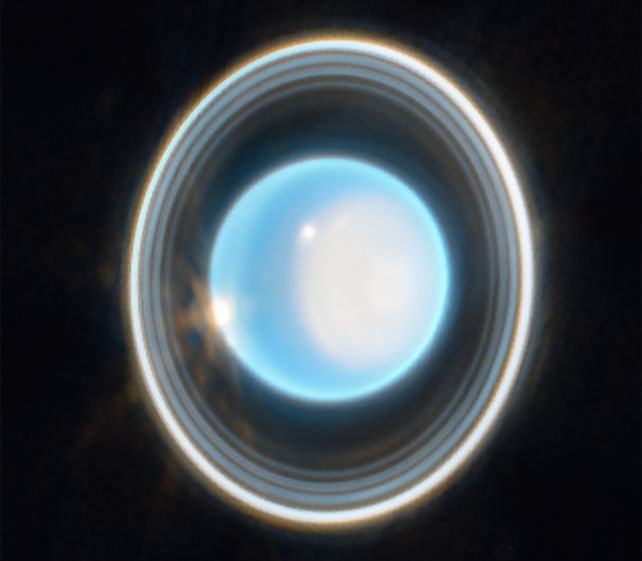 An image obtained by JWST of the rings of Uranus. (NASA, ESA, CSA, STScI, J. DePasquale)
An image obtained by JWST of the rings of Uranus. (NASA, ESA, CSA, STScI, J. DePasquale)We're yet to detect a moon outside the Solar System, but Sucerquia and his colleagues hypothesized in 2021 that should one have a large enough ring system, it could conceivably blot out enough starlight to make itself known.
But then it occurred to them that we've never actually seen a moon with rings – opening up the very real possibility that they can't exist.
Well, when you're an astronomer with a question and simulation tools at your disposal, there's only one thing to do: you make little models of cosmic systems, and study what happens when you set them wheeling into motion.
Now, there is a lot of raw material from which rings could form around different moons in the Solar System. Some are covered in craters; dust ejected during impact could potentially form a ring. Others eject vapor or gas. So no problem there.
Expecting the gravitational influence of the moon, its host planet, and possibly other moons could be too powerful for rings to settle, the researchers designed and ran tests using N-body simulations.
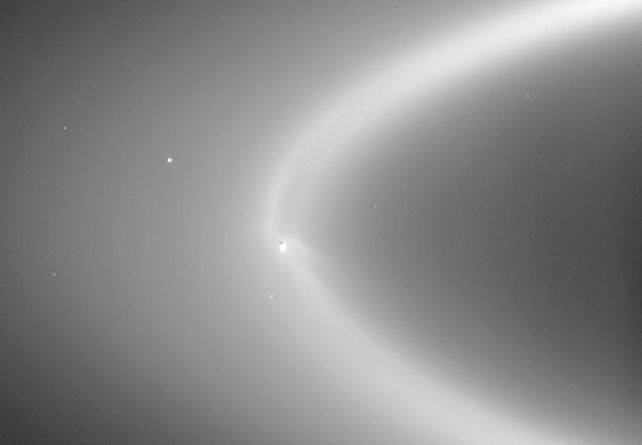 The E ring of Saturn, created from material spewed out by ice moon Enceladus, seen embedded in the ring. (NASA/JPL/Space Science Institute)
The E ring of Saturn, created from material spewed out by ice moon Enceladus, seen embedded in the ring. (NASA/JPL/Space Science Institute)"For instance, Enceladus, a moon of Saturn with significant geological activity, ejects water vapor, ice particles, and gasses from geysers in its southern polar region. Instead of forming a ring around the moon, this material is transferred to the planet's orbit due to intense interactions with neighboring moons, feeding Saturn's E ring," Sucerquia explained.
"In other words, while moons generate part of the raw material for rings, the surrounding environment ensures that the more massive planet retains it, preventing the formation of rings around the moons themselves."
To date, NASA tallies 293 moons in orbit around planets in our Solar System, most of which are attendant on Jupiter and Saturn. There are also moons orbiting dwarf planets and even asteroids.
Sucerquia and his team designed their simulations to mimic the moons that can be found around Solar System bodies, from Earth with its one moon to the larger satellites of Juputer and Saturn, over a million years of evolution. They wanted to study the stability of these objects, their gravitational environment, possible ring systems, and how they changed over time.
And the results were not at all what the researchers expected.
"I initially expected the rings to be completely unstable, which would have directly answered the question. However, contrary to our expectations, we found that these structures were quite stable in many cases," said Sucerquia.
"In fact, we had previously demonstrated in an earlier paper that isolated moons can have stable rings, but we did not anticipate that moons in a hostile gravitational environment, with many other moons and planets disturbing their rings, would still maintain stability. The additional surprise came when we realized that these hostile environments, rather than destroying the rings, actually endowed them with great beauty by creating structures like gaps and waves, similar to those observed in Saturn's rings."
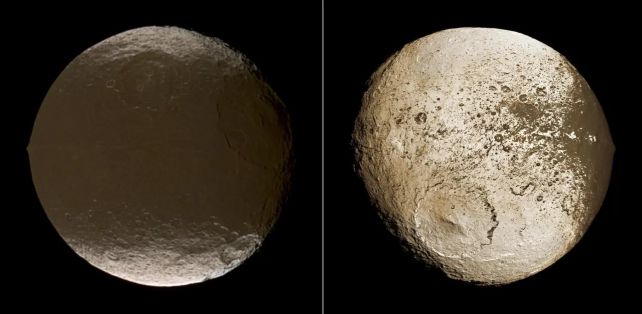 Saturn's moon Iapetus, with its distinctive equatorial ridge. (NASA/JPL-Caltech/Space Science Institute)
Saturn's moon Iapetus, with its distinctive equatorial ridge. (NASA/JPL-Caltech/Space Science Institute)There are some features on Solar System moons that indicate the past existence of rings. The simulations support suggestions that debris found orbiting Saturn's moon Rhea could be the last remnants of what was once a full ring system. And Saturn's moon Iapetus has an equatorial ridge that could be the remains of a ring that fell onto the moon, just as Saturn's rings are slowly raining into the gas giant.
These findings suggest that the reason we see no moon rings in the Solar System is because we just weren't in the right place at the right time. Radiation pressure from the Sun, magnetic fields, internal heating, and magnetospheric plasma have all contributed to the loss of any moon rings that once existed, the researchers say.
"I believe we might have been somewhat unlucky in this regard, as we started observing the Universe during a period when these structures are no longer present. After conducting this study, I am convinced that these rings likely existed in the past," said Sucerquia.
That's kind of a downer. But very plausible. Studies suggest that the only reason we see Saturn's rings is because we are in the right place at the right time. We only see the eclipses we do for the same reason; the Moon is moving away from Earth, and in time will be too far to completely block out the Sun.
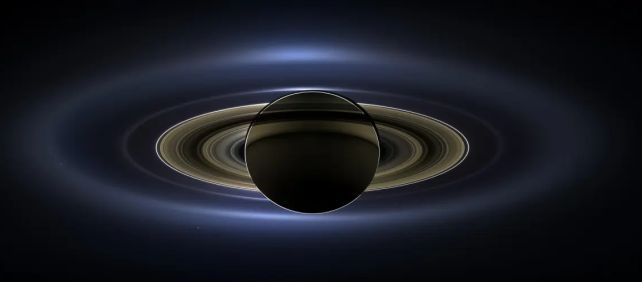 The glorious (if temporary) rings of Saturn. (NASA/JPL-Caltech/Space Science Institute)
The glorious (if temporary) rings of Saturn. (NASA/JPL-Caltech/Space Science Institute)The researchers believe that further simulations that include more parameters, such as radiation pressure and magnetic fields, could help us understand the lack of moon rings in more detail. We should also, Sucerquia suggested, study the moons more carefully, looking for past evidence of rings, such as Iapetus' ridge.
Meanwhile, he and his colleagues are broadening their search, looking for ringed moons that might be orbiting alien worlds orbiting alien stars.
"I can't help but wonder about the mythology and stories that might emerge from inhabitants of other worlds where their moons have rings," he told ScienceAlert. "How different might our own stories and culture have been if our Moon had rings? The possibilities are endless."
The research has been accepted into Astronomy & Astrophysics and is available on arXiv.

 2 months ago
26
2 months ago
26 